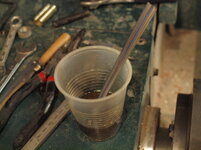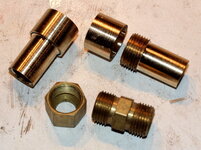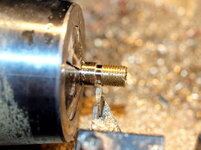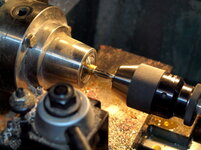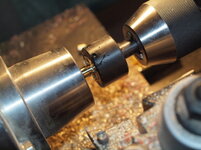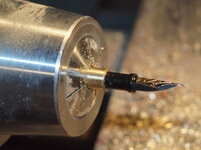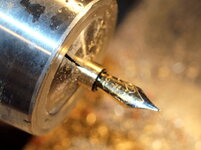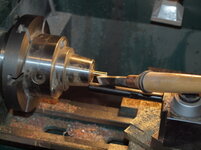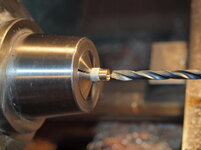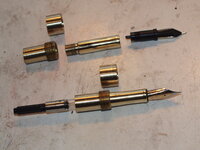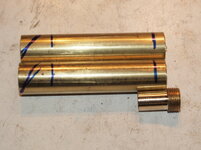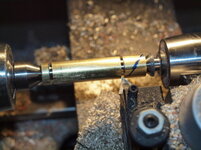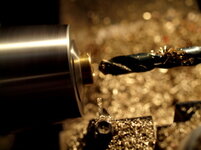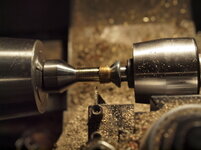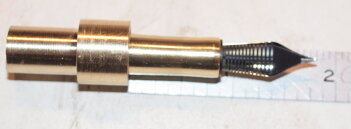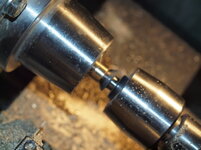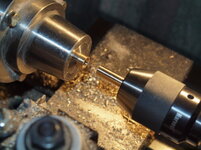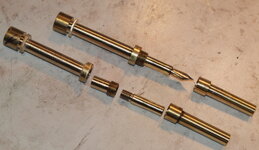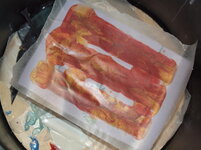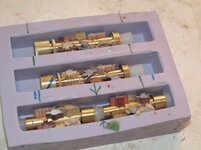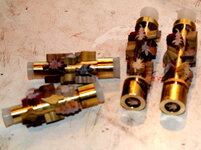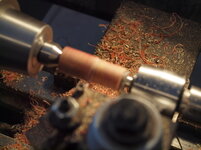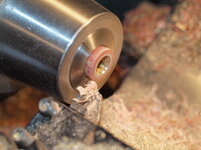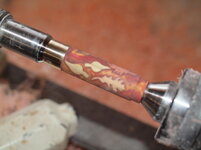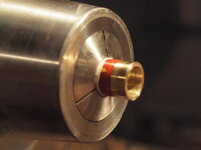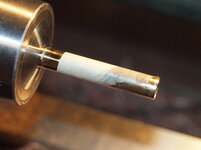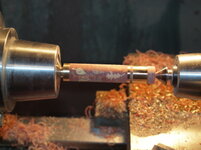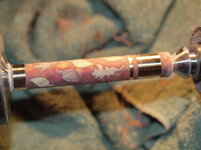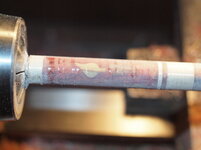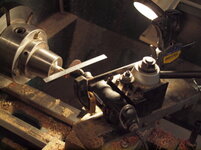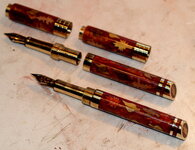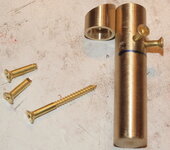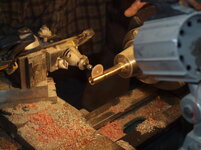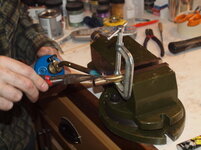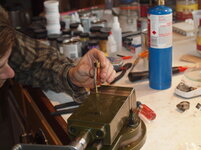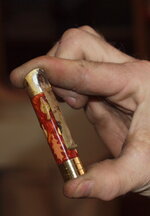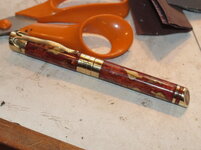workinforwood
Member
There's always lots of people wanting or thinking of making custom pens and there's a million ways to go about it. For those currently thinking about it and the few that have PM'd me about threading and what not..well here you can watch me make a pen. Can't necessarily show you every single step, but should help guide you and show you just how much work and thought is involved.
I have a bucket of brass plumbing couplers I bought years ago at an auction for a dollar and in my opinion they make the beginnings of a great little custom pen. They are 1/2" couplers with compression fittings. I know what the end result needs to be, but how I get there is just a matter of measuring whatever I'm working with..I like working off the cuff with no real plans.
I tossed out the compression rings and screwed one nut on the end. I mounted the unit between centers and spun the nut until it was round and then spun off the fixed nut with threads on the back end of the coupler.
The inside of the coupler needs to be threaded to receive a grip section. I simply grab a bunch of drill bits and stick them in the hole of the coupler and whichever drill bit fits snug will determine what tap I use. I found that an 8mm drill bit fits real nice in the hole. So I pulled out a 9x1 tap. You take the first number and that is 9mm and subract the second number which is 1 and you get 8mm. So 8 mm is the hole size for a 9x1 tap. I love metric, it's so easy.
I like to use some oil for tapping and when drilling. Just a little dixie cup with some motor oil..whatever is laying around, and an acid brush to apply the oil and clean off debris.
The coupler simply goes into a collet. The tap goes into a drill chuck. You brush some oil on the tap. You push the drill chuck into the part and you manually turn the collet chuck. For Brass..a couple turns and then a 3/4 back turn to clean the cut works great for me. You keep going until the tap goes all the way through. That's a piece of cake.
Now you need a grip section. I used solid 3/8 brass rod. You need to know how long you want your grip. I like 1" ..easy number. With some calipers, you need to measure down into the hole of the coupler because there is a shoulder in there before you get to the threads and the threads themselves add to the length...in my case, the total rod needs be 1 5/8 long in order to screw in and still have an inch hanging out the end. So I chucked up the rod and parted it clean. I am using a meister nib #6. This requires a 7.4x.5 tap. So what will be the hole size ? 7.4-.5 is 6.9. So I drill a 6.9 mm hole all the way through the grip. I then make a tennon on one end of the grip to receive the threads. I find it best to cut outside threads first, inside threads last. The threads in the coupler I made where 9x1. For outside threads, 9 is the diameter. So I spin a tennon that is 9mm O/D. I use a die holder and the 9x1 die and put that in the drill chuck. Just like tapping, a little oil, in and out until you hit the shoulder. Now the threads at the shoulder are not as deep as the rest of the threads. I simply use a parting tool and part the threads off at the shoulder so that the grip will be able to screw right in and bottom out inside the coupler. Now you simply spin the outside of the grip until it just fits into the coupler and give it a test fit.
I have a bucket of brass plumbing couplers I bought years ago at an auction for a dollar and in my opinion they make the beginnings of a great little custom pen. They are 1/2" couplers with compression fittings. I know what the end result needs to be, but how I get there is just a matter of measuring whatever I'm working with..I like working off the cuff with no real plans.
I tossed out the compression rings and screwed one nut on the end. I mounted the unit between centers and spun the nut until it was round and then spun off the fixed nut with threads on the back end of the coupler.
The inside of the coupler needs to be threaded to receive a grip section. I simply grab a bunch of drill bits and stick them in the hole of the coupler and whichever drill bit fits snug will determine what tap I use. I found that an 8mm drill bit fits real nice in the hole. So I pulled out a 9x1 tap. You take the first number and that is 9mm and subract the second number which is 1 and you get 8mm. So 8 mm is the hole size for a 9x1 tap. I love metric, it's so easy.
I like to use some oil for tapping and when drilling. Just a little dixie cup with some motor oil..whatever is laying around, and an acid brush to apply the oil and clean off debris.
The coupler simply goes into a collet. The tap goes into a drill chuck. You brush some oil on the tap. You push the drill chuck into the part and you manually turn the collet chuck. For Brass..a couple turns and then a 3/4 back turn to clean the cut works great for me. You keep going until the tap goes all the way through. That's a piece of cake.
Now you need a grip section. I used solid 3/8 brass rod. You need to know how long you want your grip. I like 1" ..easy number. With some calipers, you need to measure down into the hole of the coupler because there is a shoulder in there before you get to the threads and the threads themselves add to the length...in my case, the total rod needs be 1 5/8 long in order to screw in and still have an inch hanging out the end. So I chucked up the rod and parted it clean. I am using a meister nib #6. This requires a 7.4x.5 tap. So what will be the hole size ? 7.4-.5 is 6.9. So I drill a 6.9 mm hole all the way through the grip. I then make a tennon on one end of the grip to receive the threads. I find it best to cut outside threads first, inside threads last. The threads in the coupler I made where 9x1. For outside threads, 9 is the diameter. So I spin a tennon that is 9mm O/D. I use a die holder and the 9x1 die and put that in the drill chuck. Just like tapping, a little oil, in and out until you hit the shoulder. Now the threads at the shoulder are not as deep as the rest of the threads. I simply use a parting tool and part the threads off at the shoulder so that the grip will be able to screw right in and bottom out inside the coupler. Now you simply spin the outside of the grip until it just fits into the coupler and give it a test fit.

